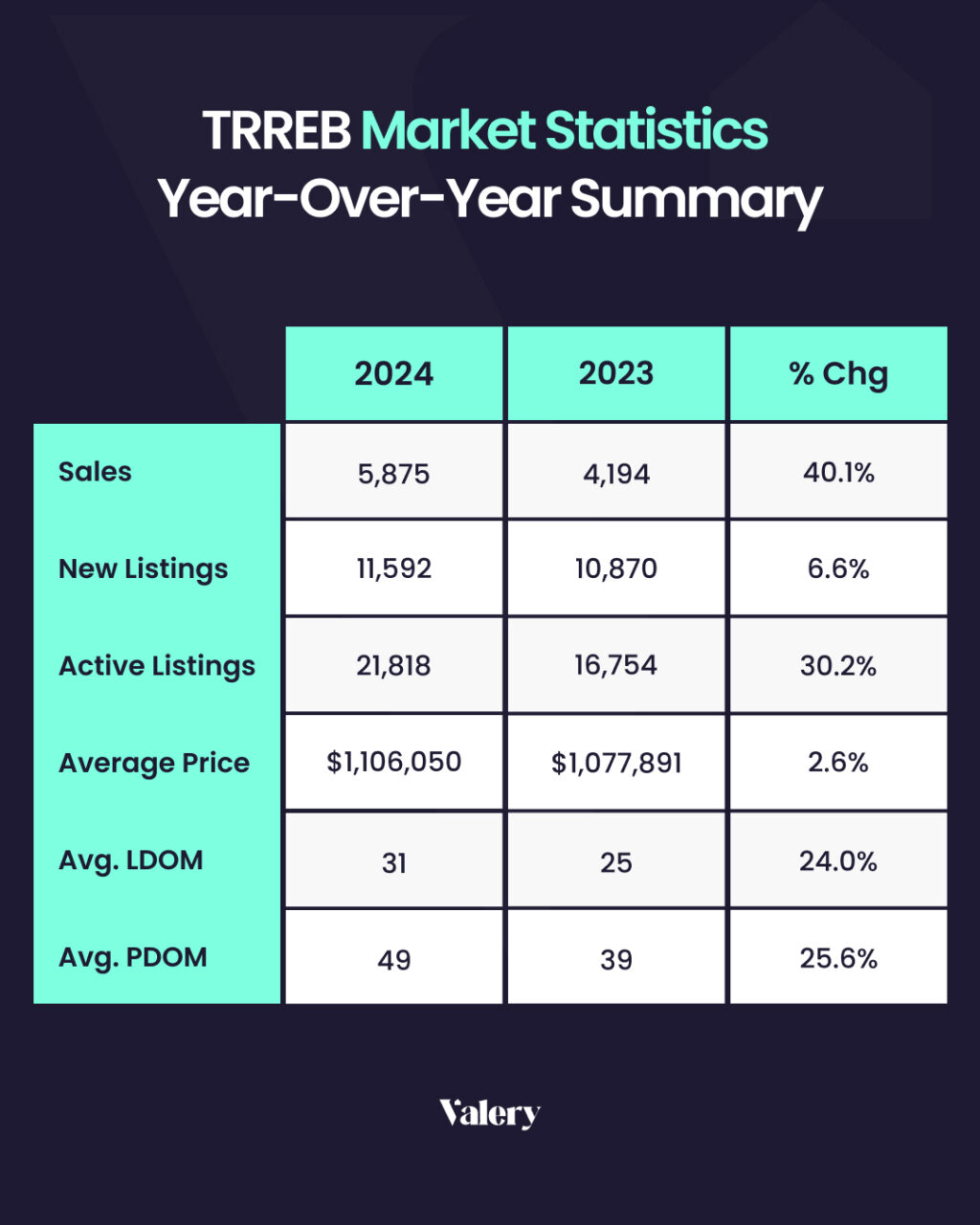The Greater Toronto Area (GTA) real estate market is beginning to show signs of renewed energy, though the picture remains uncertain. According to the Toronto Regional Real Estate Board’s latest Market Watch report for Toronto housing market, a 40.1% year-over-year increase in home sales stands out as a strong indicator of recovery. Yet, beneath this figure lies a market characterized by uneven pricing trends, modest growth in new listings, and cautious engagement from both buyers and sellers. These patterns reflect a market in transition, one gradually moving away from the volatility of recent years — driven by inflation and elevated borrowing costs — and taking its initial steps towards full stability.
Sales and Supply: Context Matters
The 40.1% jump in sales year-over-year is one of the standout highlights of the Toronto housing market report. This figure reflects buyers reentering the market after a prolonged wait-and-watch period caused by high interest rates and economic uncertainty. The uptick is promising but should be viewed in context: November 2023 was an unusually slow month for sales, amplifying the perceived growth.
On the supply side, new listings rose by 6.6%, a rate much slower than the pace of sales. This disparity has contributed to tighter market conditions, with buyers vying for a limited pool of properties. Meanwhile, active listings surged by 30.2% year-over-year, providing some relief for prospective buyers and indicating that sellers are becoming more flexible, likely due to changing market dynamics.
The sales-to-new-listings ratio, sitting at 41%, suggests the market is balanced. This ratio signifies that while sales have increased significantly, the increase in new listings, though modest, has kept the market from overheating, in spite of government policy designed to give more buying power to first-time buyers Buyers have options, but the relative scarcity of new supply ensures sellers remain in a favourable position in certain property segments, such as single family homes.
Pricing Trends: Stability with Regional Nuances
The average home price in the GTA increased by 2.6% year-over-year, reaching $1,106,050. This modest growth aligns with inflation, providing a welcome sign of stability in a market that has experienced significant fluctuations in recent years. Unlike the rapid price escalations of the past, this measured pace supports a sustainable housing market, appealing to both buyers and sellers.
However, pricing dynamics differ greatly by region and property type, reflecting localized trends:
- Detached Homes in the 416 Region: A 5.9% price increase highlights the strong demand for single-family properties in central Toronto, driven by limited inventory and buyer preferences for space and privacy.
- 905 Region Condos: Prices fell by 7.6%, underscoring the affordability challenges faced by condo sellers in suburban areas. This trend reflects buyers’ ability to negotiate more favourable deals.
- 416 Townhouses: Experiencing a 6.1% price decrease, this segment reveals a softer demand, potentially due to competition from more affordable condo units.
These variations showcase a multifaceted Toronto housing market, where affordability, location, and property type significantly influence buying decisions.

Buyer and Seller Behaviour in Toronto Housing Market: A Deliberate Shift
A major shift in the Toronto housing market behaviour is evident in the 24% increase in the average days on market compared to last year. This longer timeline reflects a more deliberate approach by buyers, who now take their time exploring available options instead of rushing to close deals. This reduced urgency can be attributed to stabilized borrowing costs and the increased inventory of active listings, allowing for greater choice.
Sellers, too, have adapted. Instead of re-listing properties to create urgency – a common practice in hotter markets – many are keeping homes listed for longer, aligning with a more measured market environment. These shifts indicate a market gradually finding equilibrium, where negotiations are less speculative and more thoughtful.
Rental Market Interplay
The GTA rental market continues to play a significant role in shaping the Toronto housing market trends overall. As borrowing costs decline and homeownership becomes more accessible, some renters are transitioning into buyers. This shift has created opportunities for those seeking affordable entry points into the housing market.
Nonetheless, population growth in the GTA ensures sustained demand for rental properties, particularly as the region continues to attract newcomers. This dual dynamic of transitioning renters and rising demand has kept the rental market competitive for both tenants and landlords.
Systemic inefficiencies, such as the backlog at the Landlord and Tenant Board (LTB), remain a challenge. TRREB CEO John DiMichele has emphasized the need for reforms to the LTB, which would streamline processes and reduce delays in addressing housing disputes. Such changes could have far-reaching effects on improving rental market conditions, ensuring greater accessibility for all stakeholders.
Looking Ahead: Foundations for Recovery
The outlook for the GTA and Toronto housing market in 2025 is cautiously optimistic. According to TRREB President Jennifer Pearce, lower borrowing costs, a steady supply of active listings, and prices remaining below historic peaks are all factors that support a more sustainable recovery. This environment benefits both buyers and sellers, fostering a balanced market where fair pricing and increased negotiation power create opportunities for all parties.
However, external factors such as continued population growth, and potential policy changes will shape the pace and scale of recovery. Economic uncertainty and geopolitical events could influence borrowing rates and housing affordability, underscoring the need for ongoing market adaptability.
Despite these challenges, the GTA real estate market appears poised for gradual growth. By transitioning away from speculative highs and embracing a balanced framework, it sets the foundation for a healthier, more sustainable future.
Frequently Asked Questions
-
How much did home sales increase in November 2024?
Home sales rose 40.1% year-over-year, reflecting renewed buyer confidence.
-
Did new listings also increase?
Yes, new listings grew by 6.6%, but at a slower pace than sales, tightening market conditions.
-
What happened to active listings?
Active listings increased by 30.2%, providing buyers with more options and balancing the market.
-
How did average home prices change?
The average price rose by 2.6% year-over-year to $1,106,050, reflecting stable growth aligned with inflation.
-
Were there regional differences in price growth?
Yes, for detached homes in the 416 region – prices increased by 5.9%. For condos in the 905 region – prices decreased by 7.6%, favouring buyers.
-
Are homes taking longer to sell?
Yes, the average days on market increased by 24%, indicating more deliberate buyer decisions.
-
How is the rental market adapting?
While some renters are becoming buyers, population growth sustains rental demand. Reforms to the LTB are crucial for addressing market inefficiencies.
-
What does TRREB forecast for 2025?
TRREB anticipates a steady recovery fueled by lower borrowing costs, stabilized prices, and balanced market conditions.
-
What is the sales-to-new-listings ratio?
At 41%, the ratio indicates a balanced market.
-
What broader trends are shaping the GTA housing market?
The market is transitioning toward stability, balancing buyer and seller needs while addressing systemic challenges like the LTB backlog and population growth.
About the Author

Daniel Foch is the Chief Real Estate Officer at Valery.ca, and Host of Canada’s #1 real estate podcast. As co-founder of The Habistat, the onboard data science platform for TRREB & Proptx, he helped the real estate industry to become more transparent, using real-time housing market data to inform decision making for key stakeholders. With over 15 years of experience in the real estate industry, Daniel has advised a broad spectrum of real estate market participants, from 3 levels of government to some of Canada’s largest developers.
Daniel is a trusted voice in the Canadian real estate market, regularly contributing to media outlets such as The Wall Street Journal, CBC, Bloomberg, and The Globe & Mail. His expertise and balanced insights have earned him a dedicated audience of over 100,000 real estate investors across multiple social media platforms, where he shares primary research and market analysis.
